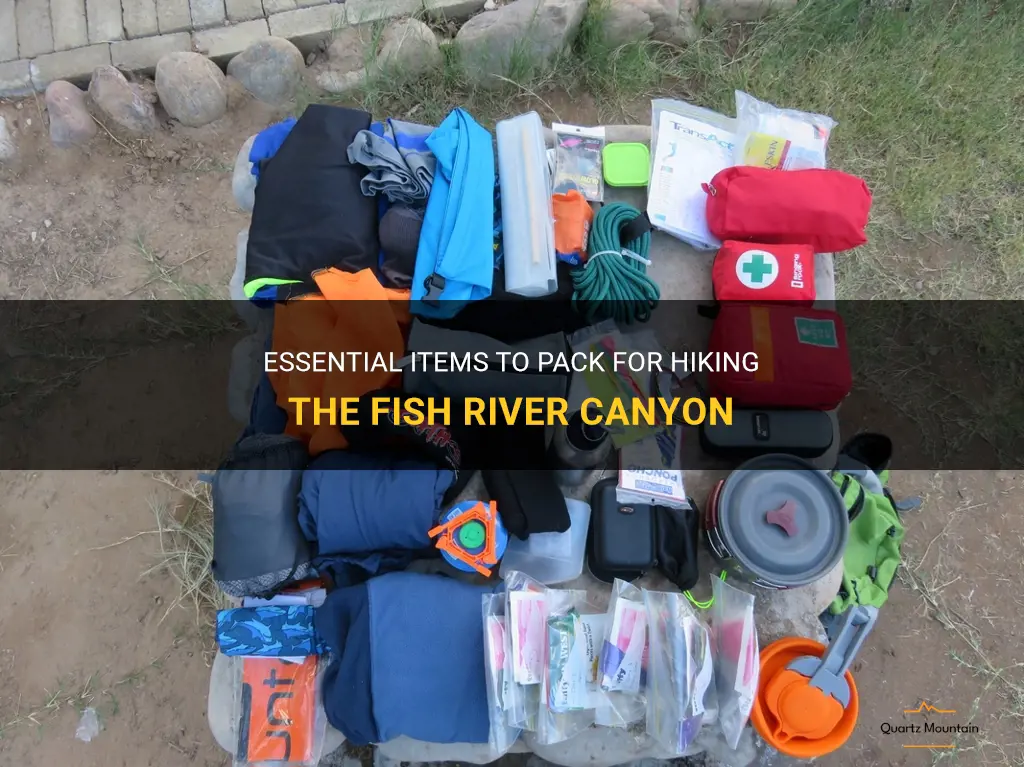
Hiking the Fish River Canyon in Namibia is an exhilarating and challenging adventure that takes you through a breathtakingly beautiful landscape of towering cliffs and winding paths. However, before you embark on this epic journey, it is essential to pack the right gear and essentials to ensure a safe and enjoyable experience. From sturdy footwear to lightweight camping gear, this guide will take you through the must-have items to pack for hiking the Fish River Canyon. So, grab your backpack and get ready to explore one of Africa's most spectacular natural wonders!
| Characteristics | Values |
|---|---|
| Duration of Hike | 5 days |
| Distance | 85 km |
| Difficulty Level | Challenging |
| Temperature Range | 5°C to 35°C |
| Best Time to Hike | May to September |
| Water Availability | Limited |
| Accommodation | Camping |
| Safety | Requires a guide |
| Packing List | Sleeping bag, tent, cooking stove, food, water, sturdy hiking boots, hiking backpack, sunscreen, hat, sunglasses, lightweight clothing, hiking poles, first aid kit, insect repellent, map and compass |
What You'll Learn
- What essential items should I pack when hiking the Fish River Canyon?
- How much water should I plan to bring on a hike through the Fish River Canyon?
- Are there any specific clothing items I should pack for a hike in the Fish River Canyon?
- What type of footwear is recommended for hiking the Fish River Canyon?
- Are there any specific safety equipment or first aid supplies I should pack for a hike in the Fish River Canyon?

What essential items should I pack when hiking the Fish River Canyon?
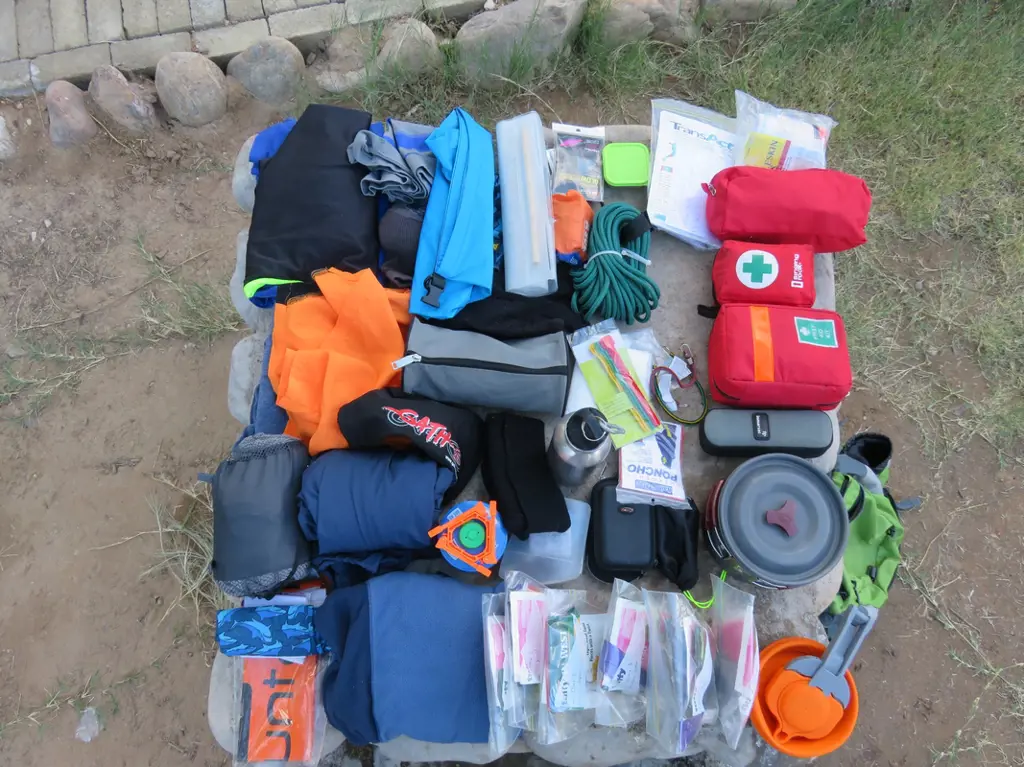
When hiking the Fish River Canyon, it is important to pack essential items to ensure a safe and enjoyable experience. The Fish River Canyon is located in Namibia and is the second largest canyon in the world, attracting many hikers and adventure seekers. To make the most of your trip, here are some essential items you should pack:
- A sturdy backpack: Choose a backpack that is comfortable and fits your body well. It should have enough space to hold all your essentials and be durable enough to withstand the rugged terrain.
- Good quality hiking boots: Invest in a pair of sturdy hiking boots that provide ankle support and grip. The terrain in the Fish River Canyon can be challenging, so it is essential to have proper footwear to prevent injuries and ensure a comfortable hike.
- Water purification tablets: The Fish River Canyon hike can take several days, and there may not always be access to clean drinking water. Carrying water purification tablets will allow you to safely drink from natural water sources along the way.
- Adequate food supply: Pack lightweight, high-energy foods that provide sustenance during your hike. Granola bars, nuts, dried fruits, and instant meals are great options. Make sure to pack enough food to last for the duration of your hike, considering any extra days you may need due to unforeseen circumstances.
- Proper clothing: Pack weather-appropriate clothing that will protect you from both the scorching desert sun and the cooler evenings. Opt for lightweight, breathable fabrics that dry quickly. Don't forget a hat, sunglasses, and sunscreen to protect yourself from the sun's harmful rays.
- Sleeping bag and camping equipment: Since the Fish River Canyon is a multi-day hike, you will need a tent, a sleeping bag, and a sleeping mat. Make sure your sleeping bag is suitable for the anticipated temperatures during your hike.
- First aid kit: Accidents can happen, so it is vital to carry a well-stocked first aid kit. Include items such as bandages, antiseptic ointment, pain relievers, blister patches, and any personal medication you may require.
- Navigation tools: The Fish River Canyon is remote and can be challenging to navigate. Bring a detailed map, a compass, and a GPS device to help you stay on track and navigate any tricky sections.
- Headlamp or flashlight: Since hiking in the canyon can involve early mornings and late evenings, having a reliable source of light is crucial. A headlamp or flashlight will come in handy when setting up camp or exploring the surroundings after sunset.
- Cash and identification: Carry some cash for emergencies and any fees you may encounter during your hike. Also, don't forget to bring a form of identification, such as a driver's license or passport, as it may be required at certain checkpoints.
Remember, preparation is key when hiking the Fish River Canyon. It is essential to pack these items to ensure your safety and comfort throughout the journey. Additionally, check the local regulations and guidelines before your trip to ensure you have all the necessary permits and information for your hike.
Essential Items to Pack for a Memorable Trip to SeaWorld San Diego
You may want to see also

How much water should I plan to bring on a hike through the Fish River Canyon?
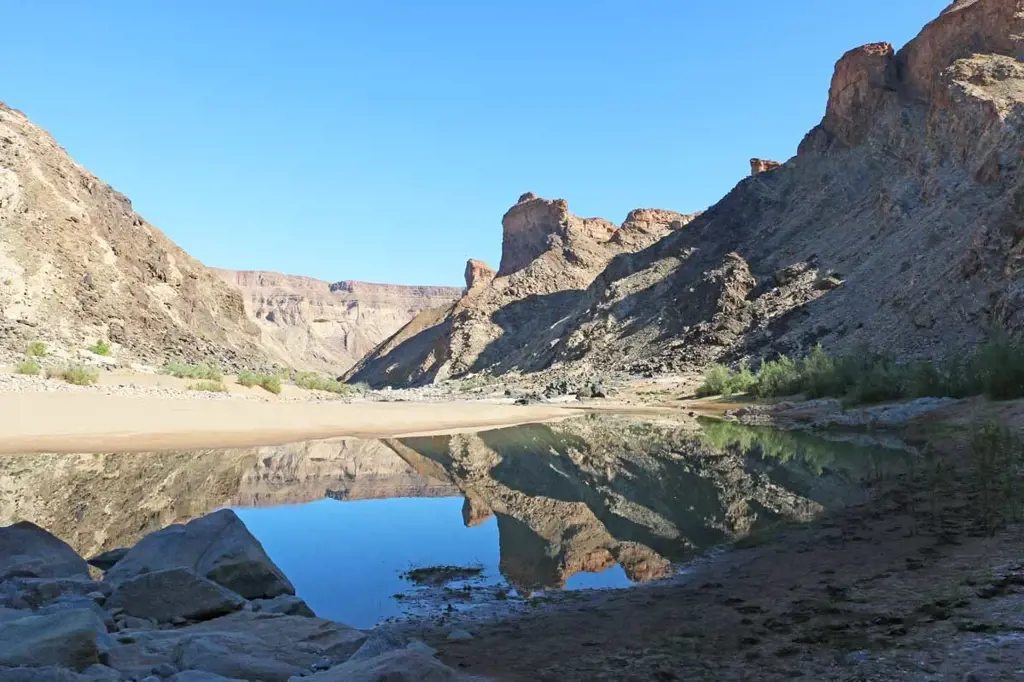
When embarking on a hike through the Fish River Canyon, it is crucial to plan and prepare properly, especially when it comes to water consumption. The Fish River Canyon, located in Namibia, is known for its arid conditions and can be a challenging trek, requiring hikers to carry sufficient water supplies. So, how much water should you plan to bring on a hike through the Fish River Canyon?
The amount of water you should bring depends on several factors, including the length of your hike, the weather conditions, and your personal hydration needs. As a general rule of thumb, it is recommended to bring at least 2-3 liters of water per person per day for a hike through the Fish River Canyon. This amount should be adjusted based on your personal hydration needs and the difficulty of the terrain.
It is essential to stay properly hydrated during your hike to avoid heat-related illnesses and to maintain your overall well-being. Here are some tips to help you plan your water consumption:
- Calculate the duration of your hike: Estimate how many days you will be hiking through the canyon. Multiply this number by the recommended daily water consumption (2-3 liters per day) to determine the total amount of water you should bring.
- Consider the weather conditions: The Fish River Canyon can experience extreme temperatures, especially during the summer months. If you are hiking during hot weather, you may need to increase your water intake to compensate for increased sweating and dehydration.
- Familiarize yourself with the terrain: The difficulty of the terrain can impact your water needs. If you are hiking through rugged and steep terrain, you may exert more energy and require additional water to stay properly hydrated.
- Plan for emergencies: It is always prudent to bring extra water in case of emergencies or unexpected delays. Having a contingency plan and additional water supplies can ensure your safety in case of unforeseen circumstances.
To give you a better understanding of the importance of water consumption on a hike through the Fish River Canyon, here is an example:
John is planning a four-day hike through the Fish River Canyon during the summer. Based on the recommended daily water consumption of 2-3 liters per day, he calculates that he will need a total of 8-12 liters of water for the entire hike.
Knowing that the temperatures can be extremely hot during the summer, John decides to bring extra water to account for increased sweating and potential dehydration. He packs a total of 15 liters of water, ensuring he has enough to stay properly hydrated throughout the hike.
During the hike, John carefully monitors his water consumption and makes sure to pace himself to avoid running out of water before reaching his next water source. He also takes advantage of any opportunities to refill his water supplies, such as natural springs or rivers.
By planning and bringing sufficient water supplies, John is able to enjoy his hike through the Fish River Canyon safely and comfortably.
In conclusion, when planning a hike through the Fish River Canyon, it is crucial to bring enough water to stay hydrated. By considering the length of your hike, the weather conditions, and the difficulty of the terrain, you can estimate the amount of water you will need and ensure a safe and enjoyable adventure. Always remember to monitor your water consumption, pace yourself, and be prepared for any emergencies that may arise.
Essential Items to Pack for a Stella Australis Adventure
You may want to see also

Are there any specific clothing items I should pack for a hike in the Fish River Canyon?
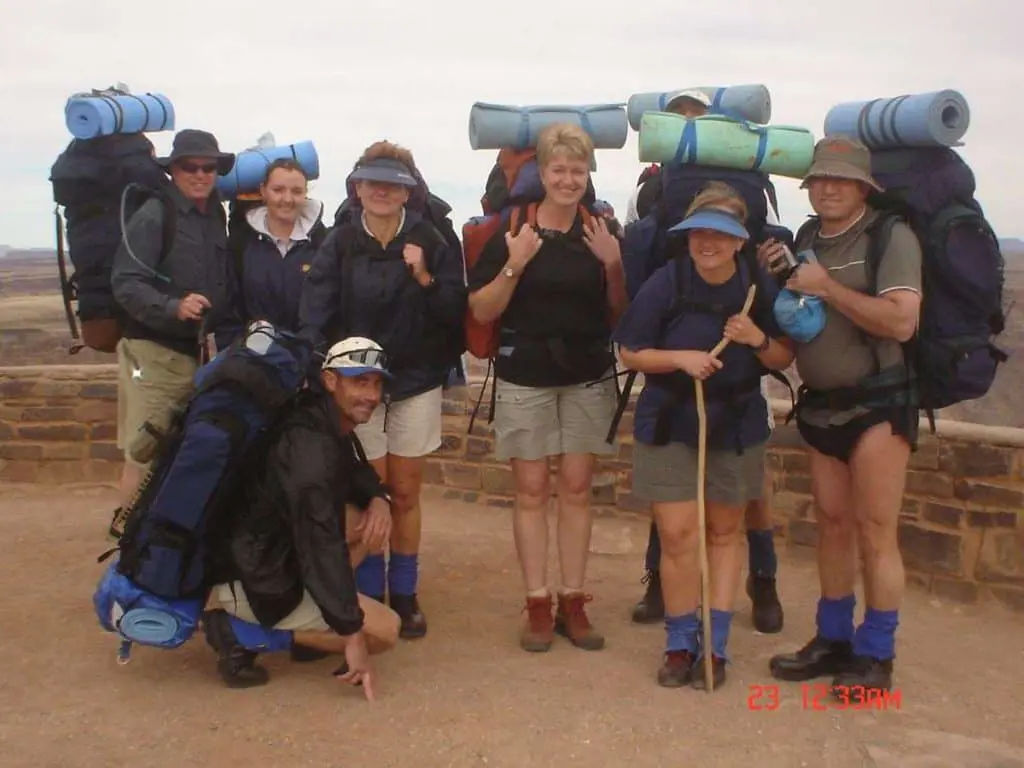
When embarking on a hike in the Fish River Canyon, it's important to pack the right clothing to ensure comfort, safety, and protection from the elements. The Fish River Canyon, located in Namibia, is one of the most beautiful natural wonders of the world, but it can also be a challenging environment to navigate. The following clothing items should be included in your packing list for a hike in the Fish River Canyon:
- Hiking boots: A sturdy pair of hiking boots is an absolute must for tackling the rugged terrain of the Fish River Canyon. Look for a pair that provides ankle support and has a good grip on the soles to prevent slips and falls. A waterproof or water-resistant pair is also advisable, as the canyon can get wet and muddy in certain areas.
- Moisture-wicking socks: It's important to wear moisture-wicking socks to keep your feet dry and comfortable throughout the hike. These socks are designed to draw moisture away from your skin, reducing the risk of blisters and discomfort. Avoid cotton socks, as they tend to retain moisture and can lead to blisters.
- Lightweight, breathable clothing: Opt for lightweight, breathable clothing that allows for freedom of movement. This could include moisture-wicking t-shirts, long-sleeve shirts, and shorts or lightweight pants. It's also wise to pack a lightweight, long-sleeve shirt and pants to protect yourself from the sun and insects during the day and to keep warm in the evenings when temperatures can drop.
- Sun protection: The Fish River Canyon is located in a desert environment, and the sun can be extremely harsh. Therefore, it's crucial to pack sun protection items such as a hat with a wide brim to shield your face and neck from the sun's rays. Additionally, don't forget to bring sunscreen with a high SPF rating to protect your skin from harmful UV rays.
- Layers: Even though the Fish River Canyon is located in a desert, temperatures can vary significantly throughout the day. It's advisable to dress in layers so that you can easily adjust your clothing according to the temperature. This could include a lightweight jacket or fleece for cooler mornings and evenings.
- Rain gear: While the Fish River Canyon is primarily a desert, there is still a possibility of rain. It's important to pack a lightweight, waterproof jacket and pants to protect yourself from unexpected showers. Additionally, a waterproof cover for your backpack is also recommended to keep your gear dry.
- Headlamp: A headlamp is an essential item for any hiking trip, especially in the Fish River Canyon. It's helpful for navigating the canyon during early morning or late evening hikes, and it can also be useful if you need to find your way in the dark.
In conclusion, packing the right clothing items for a hike in the Fish River Canyon is essential for a comfortable and safe experience. Hiking boots, moisture-wicking socks, lightweight and breathable clothing, sun protection, layers, rain gear, and a headlamp are all important items to include in your packing list. By being prepared with the right clothing, you can fully enjoy the breathtaking beauty and challenging terrain of the Fish River Canyon.
Essential Items to Pack for Your Victoria Falls Adventure
You may want to see also

What type of footwear is recommended for hiking the Fish River Canyon?
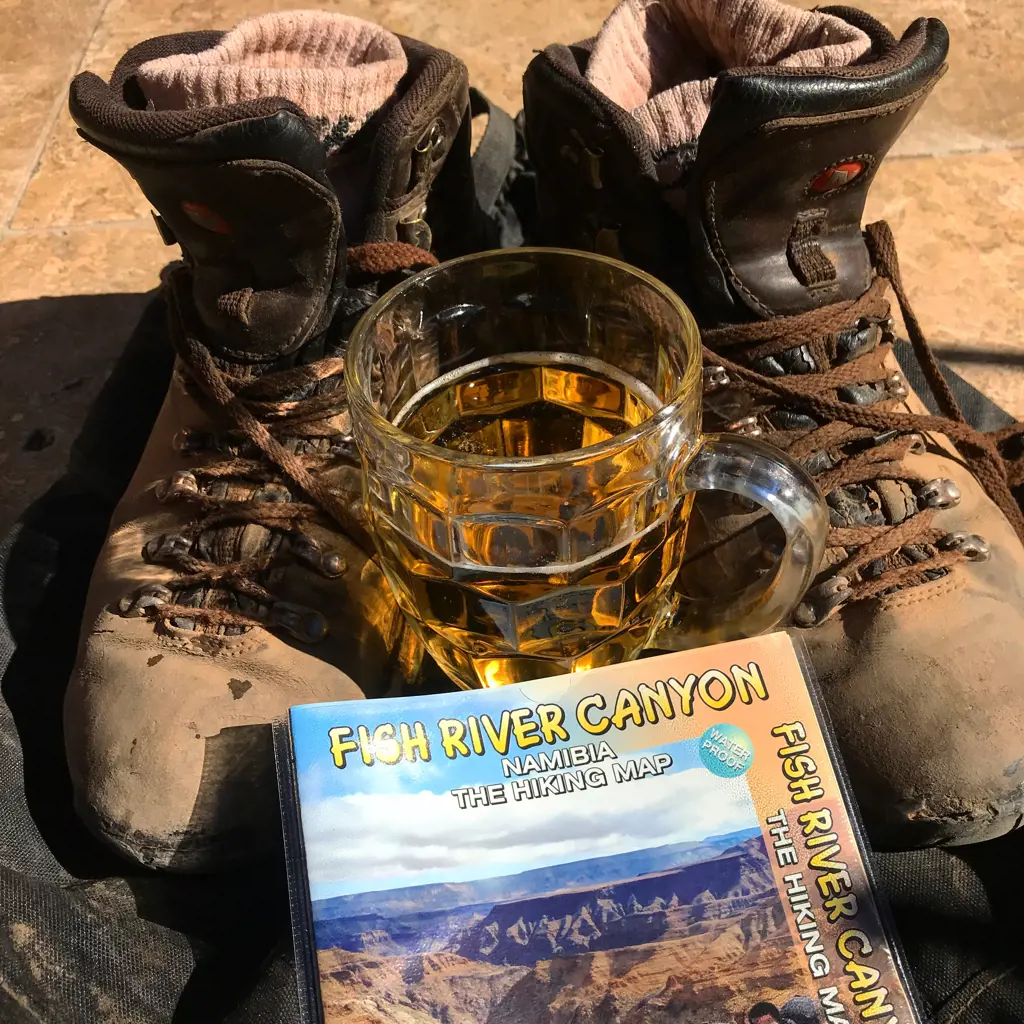
When it comes to hiking the Fish River Canyon, proper footwear is essential for a safe and enjoyable experience. The Fish River Canyon is one of the most challenging hikes in the world, with rugged terrain and extreme temperatures. Therefore, it is crucial to choose the right footwear to protect your feet and ensure comfort throughout the journey.
Scientifically, it is recommended to wear hiking boots or sturdy hiking shoes when hiking the Fish River Canyon. These types of footwear provide ankle support and stability, which is crucial when navigating through rocky and uneven terrain. Hiking boots are designed with durable materials that protect your feet from getting injured by sharp rocks or thorny plants that may be encountered along the way.
Personal experience from seasoned hikers also supports the use of hiking boots in the Fish River Canyon. They provide better grip and traction on slippery surfaces such as loose gravel or wet rocks, reducing the risk of slipping and falling. Moreover, hiking boots are typically waterproof, which is essential when crossing streams or encountering wet areas during the hike.
Step-by-step, it is recommended to break in your hiking boots before embarking on the Fish River Canyon hike. This means wearing them on shorter hikes or walks to allow your feet to adjust to the new footwear. Breaking in your boots helps prevent blisters and discomfort during longer hikes, allowing you to fully enjoy the experience.
Lastly, examples of suitable hiking boots for the Fish River Canyon include those made by reputable outdoor brands such as Merrell, Salomon, or Columbia. These brands offer a wide range of hiking boots that are specifically designed for rugged terrains and long-distance hikes. Look for boots with features such as waterproofing, ankle support, and a sturdy outsole for maximum durability.
In conclusion, when hiking the Fish River Canyon, it is recommended to wear hiking boots or sturdy hiking shoes. These types of footwear provide ankle support, traction, and protection, ensuring a safe and enjoyable experience. Remember to break in your boots before the hike and choose a pair from reputable outdoor brands that offer durability and the necessary features for hiking in challenging terrain. Stay safe and have a great hike!
The Essential Packing Guide for Traveling to Costa Rica
You may want to see also

Are there any specific safety equipment or first aid supplies I should pack for a hike in the Fish River Canyon?
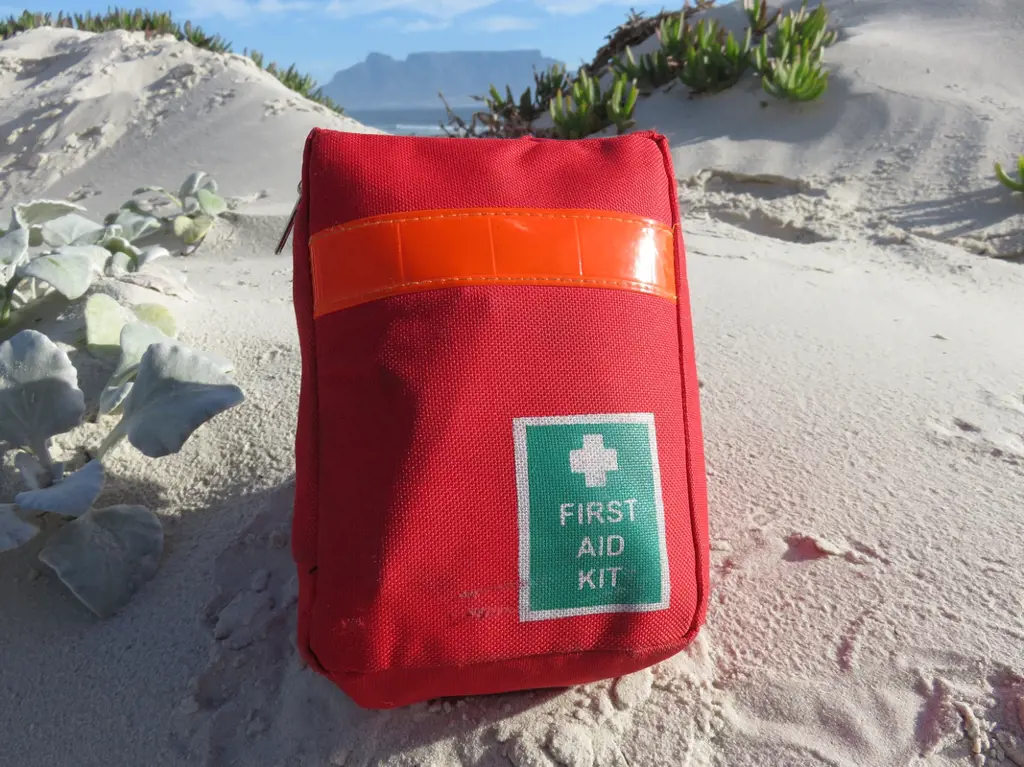
Whether you are an experienced hiker or new to the adventure, it is essential to be well-prepared for a hike in the Fish River Canyon. The Canyon, located in Namibia, is one of the most breathtaking and challenging hiking destinations in the world. As you embark on this incredible journey, it is crucial to have the right safety equipment and first aid supplies to ensure your well-being and address any unforeseen emergencies.
- Proper footwear and clothing: The rocky terrain and desert climate of the Fish River Canyon demand appropriate footwear and clothing. Opt for comfortable, sturdy hiking boots that provide ankle support and have a good grip. Choose moisture-wicking clothing that offers protection against the sun and heat, such as lightweight long-sleeved shirts and pants. Don't forget a wide-brimmed hat and sunglasses to shield yourself from the sun's harmful rays.
- Navigation tools: The Fish River Canyon hike requires a certain level of navigation skills. Make sure to carry a detailed map of the hiking trail, a compass, and a GPS device. These tools will help you stay on track and prevent you from getting lost in the vast expanse of the canyon.
- Adequate water supply: The arid environment of the Fish River Canyon can quickly dehydrate hikers. It is vital to carry a sufficient amount of water to stay hydrated throughout the hike. Experts recommend carrying at least three liters of water per person per day. Consider using a hydration bladder or water bottles that are easy to access and refill.
- First aid kit essentials: Accidents can happen on any hike, and it is imperative to have a well-stocked first aid kit. Some essential items to include are bandages, adhesive tape, antiseptic wipes, tweezers, insect repellent, sunscreen, pain relievers, and any personal medications you may need. Familiarize yourself with the contents of the kit and how to use them.
- Emergency communication devices: In case of an emergency, it is crucial to have a way to communicate with the outside world. Carry a fully charged mobile phone and a backup power bank to ensure you can make calls if needed. Consider investing in a personal locator beacon (PLB) or satellite phone for more remote areas of the canyon where cell reception may be limited.
- Emergency shelter: While planning for the worst-case scenario, it is advisable to carry a lightweight emergency shelter, such as a space blanket or a bivvy bag. This will provide protection against extreme weather conditions and keep you warm in case you need to spend the night unexpectedly.
- Knowledge and skills: Along with the proper equipment, it is essential to have the necessary knowledge and skills to navigate and handle emergencies. Familiarize yourself with the terrain, weather conditions, and potential hazards of the Fish River Canyon. Take a wilderness first aid course to learn basic first aid techniques and how to handle common hiking-related injuries.
Remember, preparation is key when embarking on a hike in the Fish River Canyon. By having the right safety equipment and first aid supplies, you are ensuring a safer and more enjoyable experience. Always prioritize your well-being and be prepared for any situation that may arise during your adventure in this stunning natural wonder.
Essential Items to Pack for an Unforgettable Motorcycle Trip to Sturgis
You may want to see also
Frequently asked questions
When hiking the Fish River Canyon, it is important to pack essentials such as sturdy hiking boots, a backpack, and a sleeping bag. These items are crucial for a successful and comfortable hike. Additionally, it is important to pack enough food and water to sustain yourself throughout the trek, as there are limited resupply options along the way.
It is recommended to bring a tent when hiking the Fish River Canyon, as there is limited accommodation available along the route. Camping is the most common and preferred option for hikers, as it allows for greater flexibility and immersion in the surrounding nature. Be sure to bring a lightweight and durable tent to minimize weight while still providing adequate shelter.
When packing clothing for a hike in the Fish River Canyon, it is important to consider the weather and terrain. Opt for lightweight, moisture-wicking clothing that is suitable for warm climates. It is also important to pack layers, as temperatures can vary throughout the day. Don't forget to pack a wide-brimmed hat, sunglasses, and sunscreen to protect yourself from the sun's rays.
Yes, there are several safety items that you should pack when hiking the Fish River Canyon. These include a first aid kit, a map and compass or GPS device, a whistle or signaling device, a headlamp or flashlight, and a knife or multi-tool. Additionally, pack a personal locator beacon or satellite communication device for emergencies. It is also important to inform someone of your hiking plans and expected return date.







